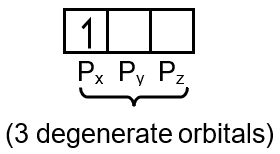Not considering the electronic spin, the degeneracy of the second excited state (n = 3) of H atom is 9, while the degeneracy of the second excited state of H– is:
single electron species don’t follow the (n + ℓ) rule but multi electron species do.
Ground state of H– =1s2
First excited state of H- = 1s1, 2s1
Second excited state of H- =1s1, 2s0, 2p1

We are comparing the degeneracy of the second excited state (n=3) for two systems: the Hydrogen atom (H) and the Hydrogen anion (H⁻). For the Hydrogen atom, it is given that the degeneracy is 9 (ignoring electron spin). We need to find the degeneracy for H⁻ in its second excited state.
Degeneracy refers to the number of distinct quantum states that have the same energy. For a hydrogen-like atom, the energy depends only on the principal quantum number and is given by:
where is the atomic number and is the Rydberg constant.
The total degeneracy for a given energy level is the sum of the degeneracies from all possible orbital angular momentum states. For each , the possible values of the orbital quantum number are . For each , there are values of the magnetic quantum number .
Therefore, the orbital degeneracy for a shell is:
For the Hydrogen atom (H, Z=1), the second excited state is n=3. Ignoring electron spin, the degeneracy is indeed .
Step 1: Identify the System
The Hydrogen anion, H⁻, is a two-electron system. Its energy level structure is not hydrogen-like. The presence of a second electron means the electrons interact with each other, and the simple formula no longer applies. The energy now depends on both the principal quantum number and the orbital angular momentum .
Step 2: Determine the Second Excited State Configuration
We find the ground and excited state configurations for H⁻ by filling orbitals according to the Aufbau principle.
Therefore, the second excited state of H⁻ has the electron configuration 1s12p1.
Step 3: Calculate the Degeneracy of the 1s12p1 Configuration
We must now find how many distinct quantum states exist for this configuration. We do this by considering the possible orbital and spin states of the two electrons.
A. Orbital Degeneracy:
The total number of possible orbital configurations is the product of the individual degeneracies: .
B. Spin Degeneracy:
Each electron has a spin of with . For two electrons, the number of possible spin microstates is . These four states form a spin triplet (degeneracy=3, symmetric) and a spin singlet (degeneracy=1, antisymmetric).
C. Total Degeneracy (Orbital + Spin):
The total number of microstates is the product of orbital and spin configurations: .
However, because electrons are identical fermions, the total wavefunction (orbital × spin) must be antisymmetric under the exchange of the two electrons. This Pauli exclusion principle restricts the allowed combinations of orbital and spin states.
For the 1s12p1 configuration, the two electrons are in different orbitals (non-equivalent electrons). This means the Pauli principle does not forbid any of the 12 possible combinations; it only dictates the symmetry of the total wavefunction. All 12 states are physically allowed and have very similar energies.
Step 4: Final Answer
The degeneracy of the second excited state of H⁻ is 12.
Related Topics:
Key Formulae and Theory: